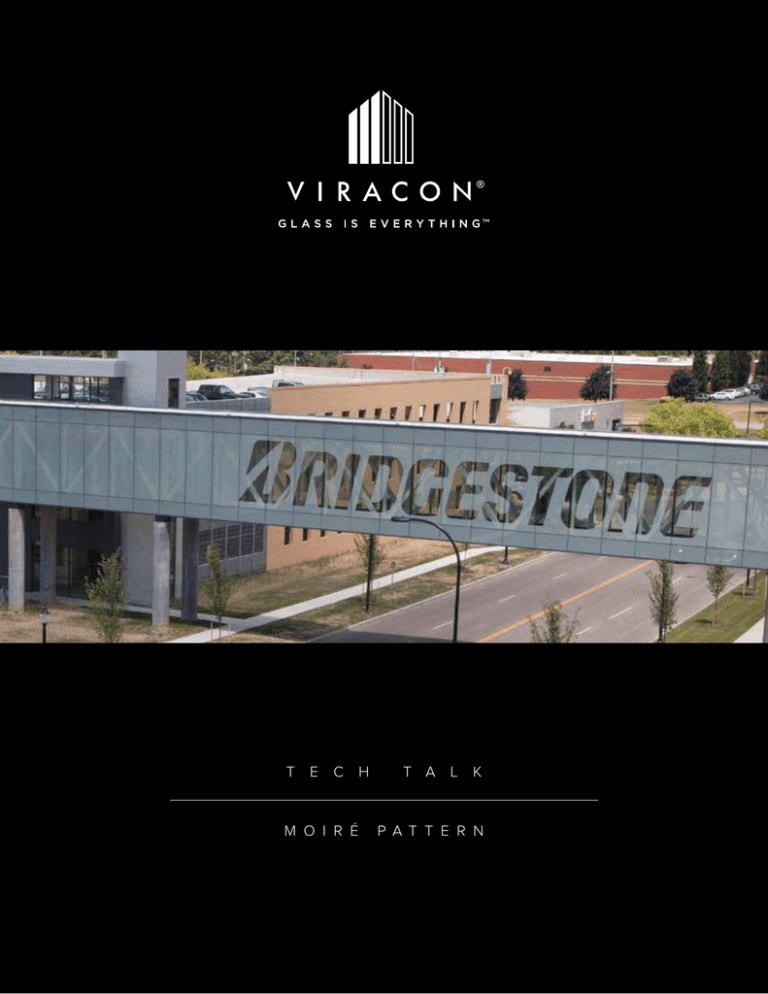
®
™
T
E
C
M O I R É
H
T A
L
K
P A T T E R N
M OIRÉ PAT T E RN
This Tech Talk provides information on an optical
phenomenon called moiré and recommendations
to minimize occurrences.
Introduction
When using silkscreen patterns in architectural
building applications, there may be, in rare cases,
a potential to see a moiré pattern develop in the
glass when viewed in certain light conditions and
at specific solar angles.
What is Moiré?
Moiré is an optical phenomenon that may present
itself as a “wavy, rippled or circular” pattern under
certain conditions. Moiré patterns can be created
whenever one semi-transparent object with a repetitive pattern is placed over another. The moiré
pattern is not a defect in the glass or silkscreen pattern, but rather a pattern in the image formed by
the eye.
HOW THE IMAGE IS FORMED
The moiré image is a pattern formed when two
regularly spaced patterns “overlap” and are not
aligned. In architectural glass applications, this may
occur when silkscreen patterns of lines or dots are
closely spaced and a secondary pattern image is
formed (as in the case of an insulating glass unit
or shadowbox assembly.) The “secondary” pattern
can be created by the shadow of the ceramic frit
on a second surface, as in the case of a spandrel
panel installed behind the silkscreened glass. Another possibility is the second pattern may be the
result of light transmitted through the glass portion
not covered with ceramic frit.
LIGHTER BACKDROPS INCREASE POTENTIAL
FOR OCCURRENCES
The potential for moiré patterns to occur is also dependent upon the color of the backdrop whether it
is another lite of glass, in the case of an insulating
glass unit, or when an aluminum panel is installed
directly behind the glass. Glass will reflect light
from each of its surfaces. When silkscreen patterns
are applied to the #2 surface of an insulating glass
unit, the image will be cast as a shadow onto the
#3 glass surface. It is the misalignment of the two
images that causes the moiré pattern. Lighter colors such as white and light gray will show these
shadow patterns more so than darker colors.
Surface Orientation
#1 Surface
#3 Surface
Exterior Ply
Interior Ply
#2 Surface
#4 Surface
Recommendations
Although it may be impossible to identify when the
potential for moiré pattern may occur, the following glass treatments are generally more prone to
exhibiting moiré patterns.
1. Closely spaced line patterns or two glass surfaces having a silkscreen pattern applied (insulating glass).
2.Silkscreen patterns using closely spaced
dots & holes.
Circular moiré pattern
3.Insulating glass units used in spandrel areas
with a silkscreen pattern on the #2 surface
and full coverage ceramic frit on the #3 or #4
surface.
continued . . .
4.Highly transparent glass such as clear or Low-E coated.
5.Shadow box applications with large spacing (i.e. >1/2”) between the silkscreen pattern and back-up
panel.
6.Light colors of full coverage spandrel glass or aluminum panels installed behind silkscreen patterns.
Special consideration must be given to the selection of colors, silkscreen patterns and application of these
products since moiré patterns are not a glass defect. Viracon recommends that a full size mock-up be
evaluated on all projects considering the use of silkscreen patterns. The mock-up should be installed at the
building site to better evaluate lighting conditions and be viewed at different times of day and under varying
temperature conditions.
®
™
The information contained in this publication is presented in good
faith. It is believed to be accurate at the time of publication. Viracon
reserves the right to change product specifications without notice
and without incurring obligation.
v iracon.com
800 Park Drive, Owatonna, MN 55060
800.533.2080
Copyright © 2003-2014 Viracon.
All Rights Reserved.
V TT- 0 0 3A
VRJC0604


